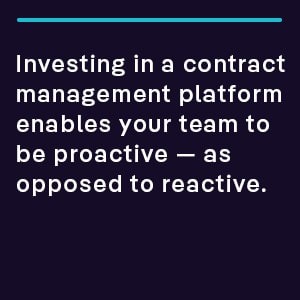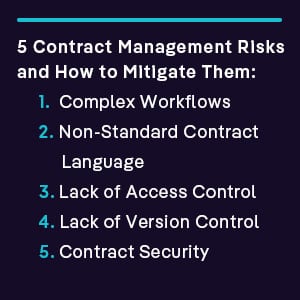Contracts are essential legal safeguards for any organization looking to mitigate risks in common business activities, like sales, purchases, joint ventures, and services agreements. Yet, entering into legal agreements with third parties also carries inherent risk. The good news is that some contract management risks can be avoided if you can recognize and navigate them before it is too late.
Naturally, if you are in a corporate legal or a contract management department, you may be familiar with some or even all of the contract management risks and associated factors. Perhaps, though, you’re faced with the need to make a business case for new contract management technology and business process re-engineering. Maybe you need to educate your colleagues across your organization on the dangers lurking just out of sight whenever they author, negotiate, close, and monitor contracts. Either way, you will find the following blog post to be a helpful resource.
Why is it Important to Monitor Contract Risks?
Monitoring contract risks can take many forms. You might track your company’s outstanding obligations to customers, or whether your suppliers and service providers are delivering on their agreed terms. Regardless of the way you proceed, monitoring contract risk is vital to ensuring that you and your clients get the maximum value from your contracts — and that your liability does not go beyond your comfort zone.
Identifying threats related to contract fulfillment allows your organization to act, like alerting project managers to approaching milestones or missed deliverables. And such action allows your organization to:
- Avoid reputational damage
- Steer clear of regulatory compliance violations and penalties
- Minimize the chance of revenue being “left on the table” due to incomplete projects or customer churn
- Protect your intellectual capital
- Create barriers to scope creep, and enforce change management discipline
- Assign clear roles and responsibilities to all parties to the contract
- Establish parameters for contract termination, liability, and penalties for unmet terms
- Mitigate the time and expense of litigation by providing unequivocal evidence of agreed terms
Investing in a contract management platform, which has an analytics engine that can identify and create alerts for risk factors, enables your team to be proactive — as opposed to reactive — around the contract risks described below.
Common Types of Contract Risks
As with many business practices, managing and minimizing contract risks requires recognizing that something is a risk in the first place. You need to classify the risk, quantify the risk’s potential and realized impact, and understand what other risks might arise should you act — or not act — on containing or removing that risk. In fact, a mentor of mine once told me that the risks that keep her up at night are those she doesn’t know about.
Here are the main risk categories that you might encounter “in the wild,” along with some general safeguards to control those risks.
Financial Risks
According to World Commerce and Contracting, organizations that have poor contract management tools, practices, and oversight lose an average 9.2% of their contract revenue. Contract management risks that affect revenue might be penalties for missed milestones or deliverables, penalties from regulations, or broken-down contract negotiations. And these particular financial risks can lead to:
- Decreased profitability/increased losses
- Credit rating damage
- Reduced cash flow and equity
Clearly, the financial risks of poor contract management impact the very ‘lifeblood’ of your organization. The failure to mitigate these threats can cripple your business and diminish your brand as a viable business going forward. However, an AI-enhanced contract management analytics engine can identify unmet obligations, problematic terms, or missed information that could cost your organization dearly.
Security Risks
Contracts contain valuable information about a company’s customers, partners, intellectual property, and practices (among other information). So, ensuring that only employees, executives, and parties with the proper privileges to your contracts can view, edit, delete, and distribute agreements is vital.
Poor contract security hygiene creates significant security risks. Security breaches can trigger litigation, fines, reputational damage, and other far-reaching repercussions. Therefore, investing in an advanced contract management systems (CMS), with access controls and multiple layers of cyber security safeguards, is your organization’s best defense against internal and external security threats.
Legal Risks
If your business breaches the terms of a contract, it is best to remediate the situation as soon as possible and get back on track. If the other party to the agreement fails to meet their promises, it may be best to terminate the agreement, especially if there are considerable or multiple breaches.
After all, the failure to meet compliance requirements related to industry regulations, like HIPAA, PCI, or Sarbanes-Oxley, can be detrimental to your business and increase auditor scrutiny in the long run. However, monitoring your contracts to ensure their workflows and language do not violate these regulations can help keep your organization out of legal jeopardy.
Brand Risks
Your brand image and reputation are critical in building trust and credibility with your prospects, clients, employees, and stakeholders. So, implementing a contract management platform that identifies risks to your brand integrity, facilitates transparent negotiations, and keeps your client data secure helps your organization maintain that trust and authority.
5 Contract Management Risks Your Team Needs to Monitor — and How to Mitigate Them 
1. Complex Workflows and Bottlenecks
When outbound and inbound contracts need to go through a multitude of approvals based on changing rules, there are bound to be bottlenecks and inefficiencies around manual processing. But workflow automation and process analytics help to identify any agreements that are stuck or progressing too slowly, so that sales or procurement transactions do not “die on the vine.”
A contract lifecycle management (CLM) solution like ContractPodAi — with digital workflow design and business process automation functionality — streamlines workflows and prompts contract administrators to address any agreements that are “stuck” in the pipeline. The predictive analytics enable in-house legal team members, contract managers, and departmental leaders to act on expiring contracts, missed obligations, and enforcing business policies.
2. Non-Standard Contract Language
Has your organization ever sent out a sales, joint venture, or HR contract — with terms or clauses which did not align with company policies — to a customer, prospective partner, or employment candidate? Well, a library of pre-vetted contract templates, clauses, and terms can take the guesswork out of contract assembly and discourage the use of the unauthorized creative license by contract authors.
Libraries of pre-approved templates and terms can accelerate contract negotiation cycles, minimize the likelihood of your organization offering up unacceptable contract terms, and adhere to industry regulatory compliance requirements. Further, onboarding all your contract authors to a CLM platform can help you author and review contract terms before you send an agreement to your negotiating partners. It can help your organization avoid committing to terms it is not prepared to live up to, ultimately.
3. Lack of Access Control and Permissions
Many organizations manage their contracts with shared drives or document repositories without proper access or digital rights controls. But they run the risk of allowing unauthorized employees or contractors to find, delete, edit, or distribute contracts without justification or permission to do so.
Fortunately, a contract management platform, with digital rights management and access controls, adds a layer of control and protection around who can see contracts being negotiated and those that have been finalized and serve as corporate records. Providing role-based security controls over visibility and editing rights on a “need-to-know basis” can save your organization from internal contract integrity threats.
4. Lack of Version Control
Ensuring that the latest, approved contract version is in play for negotiations and sign-offs can be more challenging than you would expect. For example, applying a signature to an earlier contract draft can commit your organization to terms and costs it is not prepared to live up to over time. Investing in a CLM system that can help manage iterative versions, along with tracked changes, redlining, and annotations, can deliver a fast return on investment (ROI) by mitigating the damages that human error can cause.
5. Contract Security Threats
Contract repositories store a great deal of confidential information on an organization’s employees, customers, suppliers, and intellectual property. Nevertheless, deploying, managing, and monitoring encryption and security layers that protect this sensitive information requires sophisticated IT security resources and understanding.
Alternatively, you can delegate the responsibility of managing the security of your contracts to a CLM vendor whose infrastructure is hosted on a proven cloud computing platform like Microsoft Azure, and has been certified against standards, like SOC Type 1 and ISO 27001. This can mitigate risk and protect sensitive data — and spare you from having to invest significant financial and human capital, and manage data security infrastructure and related reporting on your own.
Manage and Mitigate Contract Management Risks with Smart Contract Software
Ignoring the kinds of contract management risks described above can result in regulatory fines and reputational damage in your target market. You would do well to implement a contract lifecycle management platform that provides critical functionality, such as:
- Version control
- Digital rights management and access control
- Business process automation and workflow optimization
- Template, term, and clause repository
- AI-enhanced contract authoring, assembly, and reviews (before agreements are sent to negotiation partner)
- Identification of obligations and milestones that are at risk or past due date
- Contract analysis to identify and act on emerging threats, expiring contracts, and trends
To see how a CLM solution can help your organization mitigate contract management risks, find out more about ContractPodAi’s automated contract review.




